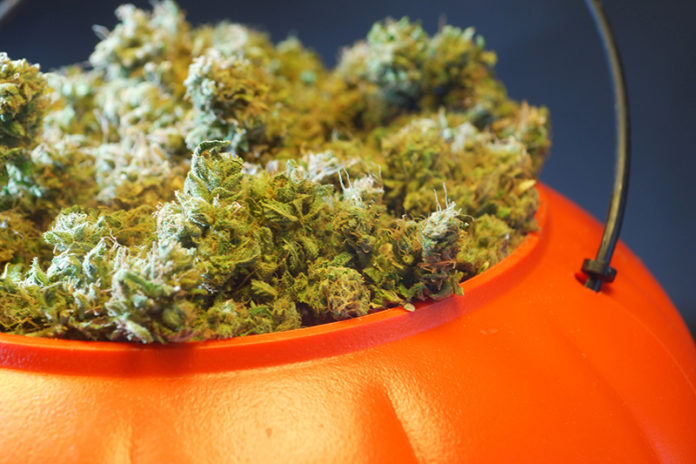It’s October, which means it’s time for concerned cops and their credulous collaborators in the news media to warn us about the mythical menace of marijuana edibles in trick-or-treat bags. The Bensalem, Pennsylvania, Police Department got a jump on the seasonal panic last week, when it alerted parents to the danger that their kids might receive THC-laced products that look like ordinary treats when they go begging for candy on Halloween.
“As Halloween gets closer,” a reporter for the ABC station in Philadelphia tweeted, “@BensalemPolice are warning parents to LOOK at your child’s candy before they eat it.
They confiscated these snacks that look a lot like the real thing. All are laced with THC.”
Jaclyn Lee, the WPVI reporter who wrote that tweet, appended photographs that included packages of “Medicated Nerds Ropes,” which Gas Buds, a California dispensary, sells for $15. You can buy the genuine, unmedicated product from Walmart for a buck.
Lee wants us to believe that people are willing to pay that sort of premium for the sake of a mean trick with consequences they would never witness. Even if such malevolent pranksters exist, their odds of success seem pretty low: All of the products in Lee’s pictures are clearly marked as marijuana edibles, including clues such as cannabis leaves, THC content and California’s state-required warning label.
The Bucks County Courier Times reported that the Bensalem alert was triggered by the arrest of 20-year-old Philadelphia resident William Goodman, who was caught with “50 pieces of THC edibles packaged to closely resemble popular candy and snack foods” after he was pulled over for an expired temporary tag. Goodman “allegedly told police he orders the candy from California and sells (it) in the city.”
Although there was no indication that any of the candy was intended for trick-or-treaters, that did not stop Bensalem Public Safety Director Fred Harran from speculating about what could happen. “Unfortunately, there’s a lot of sick and evil people out there,” Harran told the Courier Times. “This is the world we live in.”
Is it? Not according to the Nexis news database, which contains many similar warnings since 1996, when California became the first state to legalize marijuana for medical use, but no documented cases of minors who accidentally got stoned by consuming cannabis candies distributed on Halloween. As Jane Hu noted in a 2019 Slate article, “There are no actual reports of this ever happening.”
But fear springs eternal. Last year, the Indiana State Police urged parents to “thoroughly check” their kids’ Halloween hauls for marijuana edibles “packaged and marketed to look like candy,” although it contradictorily warned them that they shouldn’t “assume it’s ‘OK’ just because it looks ‘OK.'”
As in Bensalem, that alert was based on nothing more than the seizure of cannabis candy. In 2016, Bureau County, Illinois, Sheriff James Reed issued a similar warning with an even weaker basis: He mistook the maple leaves on Japanese candy wrappers for cannabis leaves.
Fears about malicious potheads bent on tricking kids into consuming THC are a variation on the old stories, going back at least to the 1950s, about razor blades, needles and poison in seemingly innocuous treats such as candied apples and chocolate bars. University of Delaware sociologist Joel Best, who specializes in deconstructing popular panics, has studied the history of such Halloween scares.
“I couldn’t find a single report of a child killed or seriously injured from a contaminated treat received during trick-or-treating,” Best told CBC News in 2019. “This is a contemporary legend, and that’s all it is.”
In addition to the perennial appeal of Halloween horror stories, the cannabis candy scares reflect local reporters’ disturbing tendency to uncritically repeat whatever police say. But judging from recent journalistic debunkings and the derisive responses to Lee’s tweet — one of which depicted “local media” as a cat lapping water from a faucet labeled “easily disproven police press releases” — people are starting to wise up.































